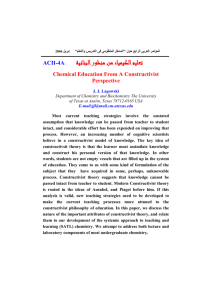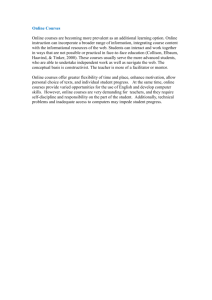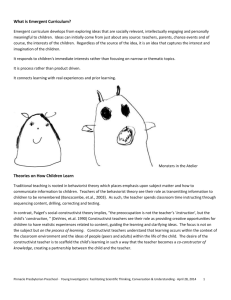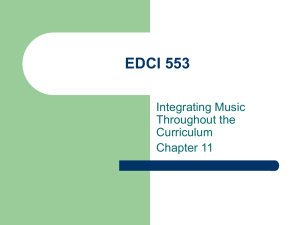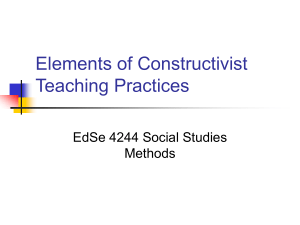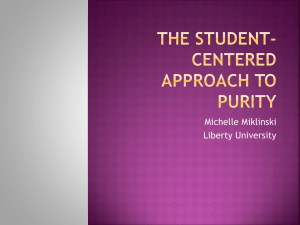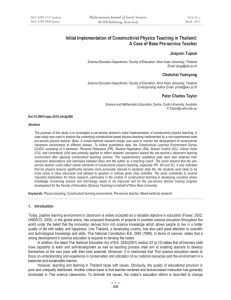Using constructivist methods to teach senior undergraduate
advertisement
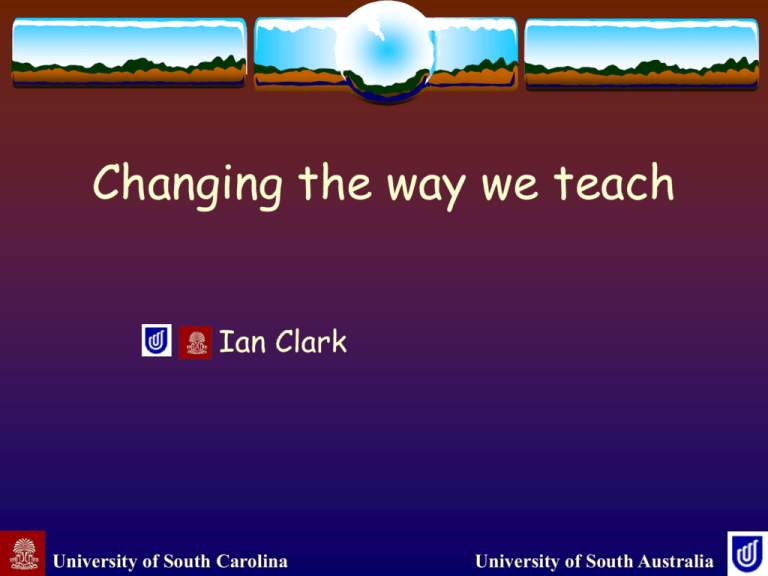
Changing the way we teach Ian Clark University of South Carolina University of South Australia Acknowledgements Dr Yvonne Zeegers from the School of Education, UniSA made a significant contribution to the planning and development of this project. Professor Patrick James and Dr Christopher Clark (Uni Adelaide) helped with the field teaching Introduction Purpose and background to the study Teaching methodology Evaluation of teaching & learning Purpose of the Study Promote meaningful learning Make students responsible for their own learning Demonstrate that constructivist methods are appropriate in tertiary classroom Confine content Control products Purpose Action research Pilot methodologies Investigate various methods of collecting data We know what we are doing works, but how do we show it Limitations of the research No control group Uncontrolled variables Background Nature of the course Taught for 5 years prior to this Optional, full semester course Final year course for Env Mgt students 4th year course for double degree students Eng/Env Mgt About 30 students/year Most had completed same introductory earth science course Few had another introductory earth science course couple had no previous experience Background Course content Introduction to the Earth System Biogeochemical evolution of the Earth Mass extinction Bolide impacts Greenhouse/icehouse – Snowball Earth Cambrian-Precambrian boundary Background Nature of the Problem Traditional didactic teaching methods Lectures, laboratories, show-&-tell fieldwork, assignments & exams Student Evaluations Students not engaged Assessment Rote knowledge Lack of understanding Poor performance on higher order thinking skills Problem-solving, analysis, synthesis, evaluation Teaching methodology Constructivist approach All learners construct their own ideas about the world Learners actively construct knowledge and meaning from their interpretation of what is happening around them, based on their own experiences and understandings Learning is an interpretive process that entails challenging and enriching one’s own thinking Constructivist Teaching No single teaching approach is always most suitable Constructivist approach demands a teaching style that differs greatly from traditional “chalk & talk” Teaching Approach De-emphasised traditional content-driven approach Recognised enormous possible scope of content Acknowledged it was too great for time allocated Encouraged students to think about their own learning Assess their needs Explore an area of interest Teaching Approach Teaching strategies focussed on: Eliciting students’ prior knowledge; Providing a range of exploratory activities designed to engage and challenge students’ thinking; Providing opportunities for students to raise questions and then investigate an area of interest Eliciting students’ prior knowledge what the students already knew about the ‘Earth System’ activity served two purposes to challenge the students’ thinking in ways that made them consider what they already knew, and then what more they wanted to know about the Earth System to collect information that would assist us to plan the content of future workshops Post Box technique Post-box questions What do you think the term “Earth System” means? What are three (3) things that are currently having an impact on the Earth System? What are two (2) things that have occurred in the Earth’s past that have had an impact on the Earth System? What are two things that could be done to protect the Earth System? What are two (2) things about the Earth System that you would like to know more about? Exploratory Activities Two sets The first activity made links to concepts that the students had been introduced to in previous courses (in classroom) The second was to demonstrate evidence that has been used to develop a model for the evolution of the Earth System (in field) Teaching Approach Encouraged interpretive discussions Change in roles Lecturer became a facilitator Student changed from a “ passive absorber of knowledge” to an active participant taking responsibility for learning Teaching methodology Clasts angular Clasts unsorted Range of compositions Conclusion: probably glacial Explain how this rock might have formed? New information Rock formed near sea-level, near equator Explain how this rock might have formed? Teaching methodology Teaching methodology Teaching Approach Teaching strategies focussed on: Eliciting students’ prior knowledge; Providing a range of exploratory activities designed to engage and challenge students’ thinking; Providing opportunities for students to raise questions and then investigate an area of interest Field notebooks Traditional use Added use Record observations Record what instructor says Record questions Provided the students with a mechanism for reflecting on their learning Provided us with a means of gaining some insight into the development of their thoughts and understandings about the Earth System Raising Questions Questions were a pivotal part of the teaching and learning approach Big and little questions Little question ‘What causes the layers to become tilted?’ Big question What caused Snowball Earth to return to normal Earth?’ Evaluation of Teaching & Learning Comparison of marks Student evaluation of teaching questionnaires Focus group interviews Informal observations Results Comparison of marks Traditional teaching Constructivist teaching High +ve correlation with other courses High +ve correlation with other courses No significance difference between course means significant difference between this course mean and 2 of the other 3 Results Student evaluation of teaching questionnaires Summative part – 10 questions –7 point Likert scale Mean = 5.59 SD = 0.25 All questions skewed towards Strongly Agree 16 14 12 10 Q1* Q2 Q3 8 6 4 2 0 1 2 3 4 5 6 7 Q 1 Aims & objectives clear from outset Q2 Staff member made course interesting Q3 Staff member motivated me to do my best work. 16 14 12 10 *Q4* Q5 Q6* 8 6 4 2 0 1 2 3 4 5 6 7 Q 4 provided adequate opportunities for me to pursue my own learning Q5 Staff member helped me develop my understanding Q6 Staff member displayed genuine interest in my learning 14 12 10 Q7 Q8 Q9 Q10 8 6 4 2 0 0 0 0 0 7 13 5 Q 7 gave me helpful feedback Q8 Staff member used up-to-date T&L approaches Q9 made University grad qualities clear Q10 overall satisfaction Results Frequency Q11- The course was taught in a way that facilitated my learning. 14 12 10 8 6 4 2 0 Old New 1 2 3 4 Score 5 6 7 Results Q19- My understanding of the subject has been increased as a result of the way this course has been taught. Frequency 15 10 Old New 5 0 1 2 3 4 Score 5 6 7 Results Q20-My learning has been enhanced by the way this course was taught. Frequency 15 10 Old New 5 0 1 2 3 4 Score 5 6 7 Results Student evaluation of teaching questionnaires Formative part What were the best parts Field work Being able to choose own topic “none-the teaching sucks” How could teaching method be improved More help in refining the research question Give more information (small number) Have more lectures (one person) Focus Group Results Question 1 – Do you think the emphasis on recording (in your notebooks) your questions for later discussion & clarification helped your learning? All students agreed. Several thought more time should have been spent addressing the questions. It was considered especially helpful when completing the research project. There was strong agreement that the process aided learning. Results Focus Group Question 2 – Did the process of framing your own research question make a difference to the way you approached the assignment The response was mixed (No = 4 Yes = 3) Those who did not like the process wanted more direction such as a set of questions to choose from. Others liked the freedom to pursue a topic of interest. There was also some concern about conflicting ideas in the literature Results Focus Group Question 3 – Did you perceive the workload for this course to be any different to that of other courses that you have or are doing? • The consensus was no difference, but some students spent more time researching their question than they would normally have done for a set question Results Focus Group Question 4 – Do you think this approach to teaching helped your learning • All agreed that it was better than ‘lecture, classroom’ approach; it encouraged thinking; students gained better understanding. It was suggested that it suited some students more than others Results Focus Group Question 5 – In what ways do you think this approach to teaching affected your learning? • No consistent theme in answers to this question. Results Student cohorts No significant difference in marks between student groups (EM, Eng, etc.) Content Students’ assignment questions very similar to those used during the more traditional approach Conclusions Generally +ve evaluations suggest students like method Evidence suggests that this approach does not disadvantage students Possible to confine content Improvements Allow more time for students to develop their questions Explain the methodology better to students Introduce the method earlier in program Conclusions Improving Student learning As Ramsden (1988) asserts, “improving learning is about the relations between the learner and the course matter and an essential aspect of teaching and learning is to understand the students’ perspectives, their perceptions of learning and their previous experiences”. However we also need to be aware that students’ perspectives of what supports their learning is not necessarily the same for each student, nor the same as that of the instructor Adelaide Fold Belt Intracratonic trough Continuous deposition from ~900-500 mya 24 km of shallow water clastics & carbonates Deformation produced broad open folds & faults Exposed ever since Brachina Gorge Adelaide Outcrop Probable extent Corridor through time Precambrian/Cambrian boundary Brachina Gorge 15 kilometres Features of Corridor Through Time Stromatolites Features of Corridor Through Time Volcanic fragment Ejecta layer Features of Corridor Through Time Ediacara fossil layer Archaeocyatha Early Cambrian fossils
